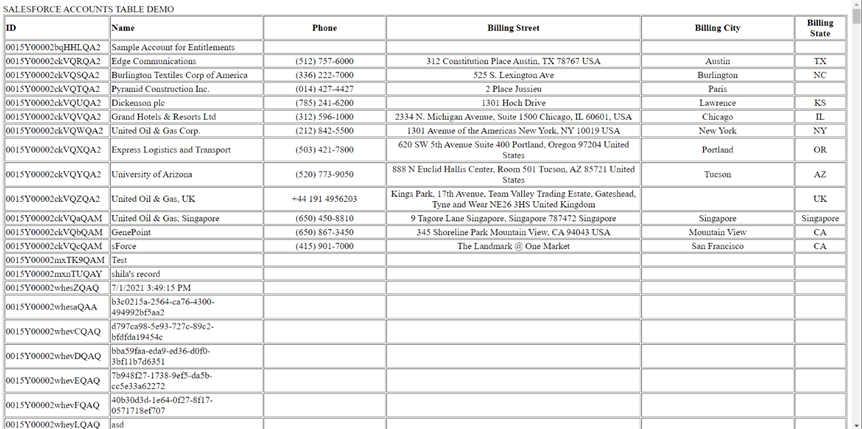Discover how a bimodal integration strategy can address the major data management challenges facing your organization today.
Get the Report →Import Real-Time SharePoint Data in ColdFusion to Build Applications
Use CData ODBC drivers to import and use SharePoint data in ColdFusion.
Adobe ColdFusion is a web and mobile application development platform. It uses its own scripting language, ColdFusion Markup Language (CFML), to create data-driven websites as well as generate remote services, such as REST. When ColdFusion is paired with the CData ODBC Driver for SharePoint, you can link your ColdFusion web and mobile applications to operational SharePoint data. This allows for your applications to be more robust and complete. This article details how to use the ODBC driver to create a table populated with SharePoint data from within a ColdFusion markup file.
To follow along with this tutorial, you need to install the CData ODBC Driver for SharePoint and Adobe ColdFusion.
Configuring the Connection
If you have not already, first specify connection properties in an ODBC DSN (Data Source Name). This is the last step of the driver installation process. You can use the Microsoft ODBC Data Source Administrator to create and configure ODBC DSNs.
Set the URL property to the base SharePoint site or to a sub-site. This allows you to query any lists and other SharePoint entities defined for the site or sub-site.
The User and Password properties, under the Authentication section, must be set to valid SharePoint user credentials when using SharePoint On-Premise.
If you are connecting to SharePoint Online, set the SharePointEdition to SHAREPOINTONLINE along with the User and Password connection string properties. For more details on connecting to SharePoint Online, see the "Getting Started" chapter of the help documentation
Adding a Data Source and Creating a Table
After creating a DSN, follow the steps below to add a new data source, test our connection to it, create a ColdFusion markup file, and, finally, import SharePoint SharePoint data and display it in a table in ColdFusion:
-
From the ColdFusion administrator interface, choose Data & Services.
![Selecting Data & Services]()
-
Here, click "Add New Data Source". The data source name can be any name, provided it conforms to the ColdFusion
variable naming conventions. For our ODBC driver, choose "ODBC Socket", then click the "Add" button.
![Adding Data Source Name]()
-
From the ODBC DSN Dropdown menu select CData SharePoint Sys. Under the Advanced Settings section, leave the
Connection String blank. Note that any properties specified in this input field will override the ones specified in the
DSN Configuration.
![Populating driver properties]()
-
Now, test the connection by pressing the check mark to the left of the CDataSharePointODBC data source you just created.
When the data source reports an "OK" status, it is ready for use.
![Testing the connection]()
-
Next, create a new ColdFusion Markup file (.cfm) and place it in the wwwroot directory ("C:\ColdFusion2021\cfusion\wwwroot")
for ColdFusion.
The following code queries the data source:
<cfquery name="SharePointQuery" dataSource="CDataSharePointODBC"> SELECT * FROM MyCustomList </cfquery>And a CFTable can be used to quickly output the table in HTML:<cftable query = "SharePointQuery" border = "1" colHeaders colSpacing = "2" headerLines = "2" HTMLTable maxRows = "500" startRow = "1"> <cfcol header="<b>Name</b>" align="Left" width=2 text="Name"/> <cfcol header="<b>Revenue</b>" align="Left" width=15 text="Revenue"/> ... </cftable>Full code, including the HTML portion is available below:<html> <head><title>CData Software | SharePoint MyCustomList Table Demo </title></head> <body> <cfoutput>#ucase("SharePoint MyCustomList Table Demo")#</cfoutput> <cfquery name="SharePointQuery" dataSource="CDataSharePointODBC"> SELECT * FROM MyCustomList </cfquery> <cftable query = "SharePointQuery" border = "1" colHeaders colSpacing = "2" headerLines = "2" HTMLTable maxRows = "500" startRow = "1"> <cfcol header="<b>Name</b>" align="Left" width=2 text="Name"/> <cfcol header="<b>Revenue</b>" align="Left" width=15 text="Revenue"/> ... </cftable> </body> </html> -
Finally, run the code in a browser. It produces a table populated with SharePoint data!
![Running the code]()
As a note, the CData ODBC Drivers also support parameterized queries using the cfqueryparam element.
For example:
SELECT * FROM Account WHERE name =
Get Started Today
Download a free, 30-day trial of the CData ODBC Driver for SharePoint and start building SharePoint-connected applications with Adobe ColdFusion. Reach out to our Support Team if you have any questions.











